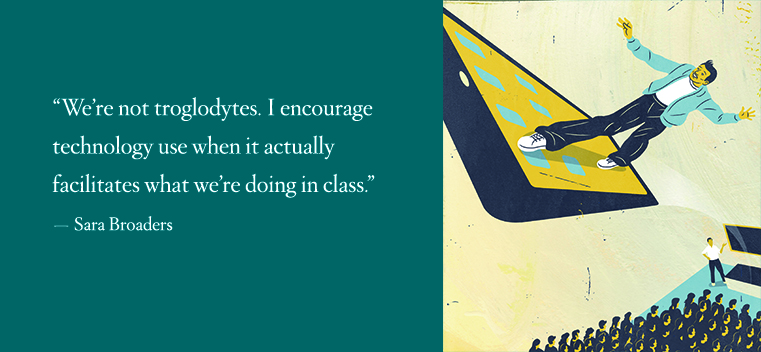
Digital Distractions
In a 1934 issue of Everyday Science and Mechanics, Northwestern president made some bold predictions about how technology would transform the university experience. He wasn't too far off.
Tell us what you think. E-mail comments or questions to the editors at letters@northwestern.edu.
Ever wonder about those strange designations we use throughout Northwestern to identify alumni of the various schools of the University? See the complete list.
Find Us on Social Media
An astronomer and a psychologist focus on the implications of technology use on classroom learning.
A few years ago Michael Smutko noticed a trend in his lecture classes — more and more he was looking out at a sea of laptop logos instead of attentive faces. “And I couldn’t help but wonder, can this be a good thing?”
Since 2009 Smutko, who teaches a large introductory astronomy course, and psychology faculty member Sara Broaders have studied how students’ in-class technology usage affects their academic performance and comprehension. In the initial study the researchers examined data usage statistics and self-reported feedback on how students used their laptops and other devices. Smutko and Broaders banned the use of electronic gadgets in one quarter — the control group — and allowed typical usage the next. They discovered that increasing use of technology had a detrimental effect on student grades.
Students who used only paper and pen to take notes during lectures earned the highest average grade (around 84 percent) for the quarter. Surprisingly, Broaders says, the students who used a laptop to take notes performed slightly worse. The students who used a laptop and reported being off task — scanning Facebook, shopping for shoes, even watching basketball — scored an average of four points lower than the paper-and-pen group.
“That’s the difference between medical school and no medical school,” says Broaders, distinguished senior lecturer and assistant director of undergraduate studies in psychology.
Multitaskers — students who are, in theory, partially on task — had the lowest scores of all. “Doing two linguistic things at the same time is almost impossible,” Broaders says of the limits of cognitive processing. “Reading websites or responding to emails, that linguistic usage cuts off any processing of the incoming lecture.”
In a follow-up experimental study of the immediate, in-class effects of technology usage, participants who used pen-and-paper notes outperformed laptop-using students in a quiz immediately following a live or recorded lecture.
Smutko, distinguished senior lecturer in physics and astronomy, says his concerns about digital devices go beyond one tuned-out pupil. “The thing about technology that’s different from reading the newspaper or doing a crossword puzzle is the wedge effect,” he says. “If somebody in the front row is watching a video, it’s in the line of sight for everybody behind him. It’s one thing if a single student wants to tune out, but when that student could affect all the others, then I really do care.”
Ben Foster, a senior psychology major from Naperville, Ill., was in two technology-banned lecture courses, one with Smutko and one with Broaders. He says he appreciated the lack of distractions in the Facebook-free environment. He says the experience also helped convert him to a pen-and-paper-only note taker.
“For a while I took notes on my phone with a Bluetooth keyboard,” Foster says. “I found that I was only concentrating on trying to type every single thing the professor said. But when I’m writing in a notebook, I really have to summarize the main point in my head and write it down in a concise way. It forces me to think.”
Susanna Calkins (GSESP05), associate director for faculty development at Northwestern’s Searle Center for Advancing Learning and Teaching, says faculty members are free to decide how much to allow or incorporate technology in the classroom. Some classes require laptops for online access or data processing, and some students, including those with disabilities, need access to digital devices, says Calkins. Many professors ask laptop users to sit in a separate section of the classroom to limit distractions.
Smutko and Broaders haven’t banned laptops in their classes, but they do share the results of their research with students on the first day each quarter. Broaders reports that laptop usage has decreased dramatically — fewer than 10 percent of her students now use digital devices.
They continue to study the in-class effects of technology usage, looking at the benefits of passive listening and examining different types of cognitive processing. They’re also studying the academic performances of students who watch a recorded lecture rather than a live lecture.
Smutko and Broaders stress that technology has its place in the classroom. “We’re not troglodytes,” Broaders says. “I encourage technology use when it actually facilitates what we’re doing in class.”



 Facebook
Facebook Twitter
Twitter Email
Email


